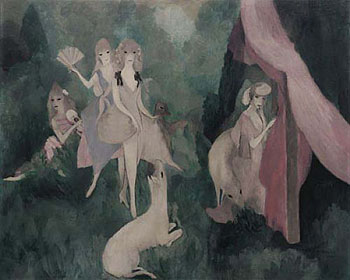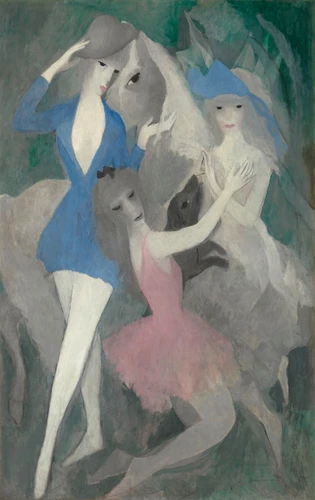The Barnes Foundation
October 22, 2023, through January 21, 2024
Beginning in the early 20th century, French artist Marie Laurencin (1883–1956) created a unique pictorial world that placed women at the center of modern art. Working in Paris, in an environment dominated by male artists, Laurencin had a highly original painting style that defied categorization. She moved seamlessly between the male-dominated cubist avant-garde, lesbian literary and artistic circles, and the realms of fashion, ballet, and decorative arts.
Laurencin became a fixture of the contemporary art scene in prewar Paris and had a passionate and tumultuous relationship with the poet and art critic Guillaume Apollinaire. Pablo Picasso introduced them in 1907, and she immediately became part of the cubist inner circle. Their breakup in 1913, combined with the death of her mother, likely prompted a hasty marriage to the German baron and artist Otto von Wätjen in 1914. The couple fled to Spain during World War I and circulated among other self-exiled artists, including Francis Picabia. In 1921, the couple divorced and Laurencin returned definitively to Paris, having developed her signature style of diaphanous female figures in a blue-rose-gray palette.
Laurencin’s feminine yet sexually fluid aesthetic defined 1920s Paris. She was commissioned by Serge Diaghilev to design the ballet Les Biches and by society figures like Coco Chanel and Helena Rubinstein to paint their portraits. Laurencin’s romantic relationships with women, particularly with the married fashion designer Nicole Groult, inspired intimate paintings that visualized the modern Sapphism of contemporary lesbian writers like Natalie Clifford Barney. One of Laurencin’s final projects was to illustrate the Poems of Sappho in 1950.
“We are proud to present the first US exhibition in over three decades dedicated to Marie Laurencin’s work,” says Thom Collins, Neubauer Family Executive Director and President of the Barnes. “Shining new light on a remarkable artist deserving of a major reexamination, this exhibition is the Barnes’s fourth in an ongoing series exploring the achievements of significant but underrecognized women working in the European modernist vanguard of the late 19th and early 20th centuries, including Suzanne Valadon, Marie Cuttoli, and Berthe Morisot.”
This exhibition holds a special significance at the Barnes; in 1923, Dr. Albert Barnes named Laurencin one of “the best French women painters” after having acquired several of her works, including Still Life with Bowl and Fruit (1907) on view in Room 10; Woman with Muff (1914) on view in Room 16; and Head (before 1921), on view in Room 11.
“Through this exhibition, we aim to reassess Marie Laurencin’s career, emphasizing the female relationships and networks—the Sapphic Paris—that Laurencin cultivated, which was just as significant to her assertion of modernity as her association with the male cubist avant-garde,” say co-curators Fraquelli and Kang. “We examine how Laurencin’s visualization of a ‘sapphic modernity’ subtly but radically challenges existing narratives of modern European art. Presenting new scholarship on her life and influence, this exhibition and catalogue tell Laurencin’s story through her art and bring new attention to her significant body of work.”
Featuring over 50 works by Laurencin from public and private collections around the world, Marie Laurencin: Sapphic Paris showcases paintings, works on paper, illustrated books, decorative objects, and ballet costumes, as well as works by Laurencin’s contemporaries and collaborators such as Max Ernst, André Mare, Jean Metzinger, and Francis Picabia. Arranged thematically and in roughly chronological order, the exhibition examines Laurencin’s interest in self-portraiture; her cubist milieu in prewar Paris; her difficult though productive period of exile in Spain; her designs for interiors and ballets; her fashionable portraits of women; and her inimitable vision of sapphic modernism.
Select exhibition highlights include:
The Woman-Horse (La femme-cheval) (1918), an enigmatic self-portrait of a woman painter in exile that shows Laurencin developing her signature style (Musée Marie Laurencin, Tokyo)
Women with a Dove (Femmes à la colombe) (1918), an intimate double portrait of Laurencin and her lover Nicole Groult (Centre Pompidou, Paris)
Spanish Dancers (Danseuses espagnoles) (1920), one of Laurencin’s largest works that depicts her unique aesthetic world intertwining women and animals (Musée de l’Orangerie, Paris)
Portrait of Miss Chanel (Portrait de Mademoiselle Chanel) (1923), a significant portrait of the famed fashion designer Coco Chanel when she was working with the Ballets Russes concurrently with Laurencin (Musée de l’Orangerie, Paris)
Also see Marie Laurencin
an exhibition organized
by Jelena Kristic
- CATALOGUE
The 208-page illustrated exhibition catalogue Marie Laurencin: Sapphic Paris is published by the Barnes Foundation in association with Yale University Press. Edited by exhibition co-curators Simonetta Fraquelli and Cindy Kang, the book includes essays from the curators, Christine Poggi, Rachel Silveri, and Jelena Kristic, along with contributions from Oriane Poret and Corrinne Chong. The authors consider Laurencin’s relationship to cubism; the pivotal period of her exile in Spain; the role of decorative projects in her career; her graphic work and illustrated books; and her interpretation of sapphic modernity. The exhibition and book illuminate how Laurencin’s work subtly but radically challenges existing histories of modern European art.






